Integrating Topography and Soil Properties for Spatial Soil Moisture Storage Modeling
Abstract
:1. Introduction
2. Materials and Methods
2.1. Description of Ziluoshan Basin
2.2. Outline of the Model
2.2.1. The Role of Soil Moisture Storage on Hydrological Fluxes
2.2.2. Site Specific Soil Moisture Storage Capacity
2.2.3. Hillslope SMSC
2.2.4. The Watershed Model Development
2.3. Model Verification
3. Result and Discussion
3.1. Sensitivity Analysis
3.2. Spatial Variation of Hydrological Components
4. Conclusions
Acknowledgments
Author Contributions
Conflicts of Interest
References
- McNamara, J.P.; Tetzlaff, D.; Bishop, K.; Soulsby, C.; Seyfried, M.; Peters, N.E.; Aulenbach, B.T.; Hooper, R. Storage as a metric of catchment comparison. Hydrol. Process. 2011, 25, 3364–3371. [Google Scholar] [CrossRef]
- Abbott, M.B.; Bathurst, J.C.; Cunge, J.A.; O’Connell, P.E.; Rasmussen, J. An introduction to the European Hydrological System-Systeme Hydrologique Europeen, SHE. 1. History and philosophy of a physically-based distributed modelling system. J. Hydrol. 1986, 87, 45–59. [Google Scholar] [CrossRef]
- Abbott, M.B.; Bathurst, J.C.; Cunge, J.A.; O’Connell, P.E.; Rasmussen, J. An introduction to the European Hydrological System-Systeme Hydrologique Europeen, SHE. 2 Structure of a physicallybased distributed modelling system. J. Hydrol. 1986, 87, 61–77. [Google Scholar] [CrossRef]
- Beven, K.J.; Calver, A.; Morris, E.M. The Institute of Hydrology Distributed Model; Report 98; The Institute of Hydrology: Wallingford, UK, 1987. [Google Scholar]
- Binley, A.; Elgy, J.; Beven, K.J. A physically based model of heterogeneous hillslopes: 1. Runoff Production. Water Resour. Res. 1989, 25, 1219–1226. [Google Scholar] [CrossRef]
- Seibert, J.; Bishop, K.; Rodhe, A.; McDonnell, J.J. Groundwater dynamics along a hillslope: A test of the steady state hypothesis. Water Resour. Res. 2003, 39, 1014. [Google Scholar] [CrossRef]
- Zhao, R.J.; Zhuang, Y.L.; Fang, L.R.; Liu, X.R.; Zhang, Q.S. The Xin’anjiang model. In Hydrological Forecasting; IAHS Publication No. 129; IAHS Press: Wallingford, UK, 1980; pp. 351–356. [Google Scholar]
- Beven, K.J.; Kirkby, M.J. A physically based variable contributing area model of basin hydrology. Hydrol. Sci. Bull. 1979, 24, 43–69. [Google Scholar] [CrossRef]
- Pellenq, J.; Kalma, J.; Boulet, G.; Saulnier, G.M.; Wooldridge, S.; Kerr, Y.; Chehbouni, A. A disaggregation scheme for soil moisture based on topography and s O’Kane oil depth. J. Hydrol. 2003, 276, 112–127. [Google Scholar] [CrossRef]
- Bell, V.A.; Moore, R.J. A grid-based distributed flood forecasting model for use with weather radar data: Part 1. Hydrol. Earth Syst. Sci. 1998, 2, 265–281. [Google Scholar] [CrossRef]
- Guo, F.; Liu, X.R.; Ren, L.L. Topography based watershed hydrological model-TOPOMODEL and its application. Adv. Water Resour. 2000, 11, 296–301. (In Chinese) [Google Scholar]
- Chen, X.; Chen, Y.D.; Xu, C.Y. A distributed monthly hydrological model for integrating spatial variations of basin topography and rainfall. Hydrol. Process. 2007, 21, 242–252. [Google Scholar] [CrossRef]
- Kong, F.Z.; Song, X.M. A Computation Method for Spatial Distribution of Soil Moisture Storage Capacity in Xin’anjiang Model. J. China Hydrol. 2011, 31, 1–14. (In Chinese) [Google Scholar]
- Dumenil, L.; Todini, E. A rainfall-runoff scheme for use in the Hamburg climate model. In Advances in Theoretical Hydrology, A Tribute to James Dooge; O’Kane, J.P., Ed.; Elsevier Science Publishers B.V.: Amsterdam, The Netherlands, 1992; pp. 129–157. [Google Scholar]
- Blyth, E.M.; Finch, J.; Robinson, M.; Rosier, P. Can soi1 moisture be mapped onto the terrain? Hydrol. Earth Syst. Sci. 2004, 8, 923–930. [Google Scholar] [CrossRef]
- Carman, P.C. Capillary rise and capillary movement of moisture in fine sans. Soil Sci. 1941, 52, 1–14. [Google Scholar] [CrossRef]
- Fan, Y.; Miguez-Macho, G.; Weaver, C.P.; Walko, R.; Robock, A. Incorporating water table dynamics in climate modeling: 1. Water table observations and equilibrium water table simulations. J. Geophys. Res. 2007, 112, D10125. [Google Scholar] [CrossRef]
- Todini, E. The ARNO rainfall-runoff model. J. Hydrol. 1996, 175, 339–382. [Google Scholar] [CrossRef]
- Van Genuchten, M.Th. A closed-form equation for predicting the hydraulic conductivity of unsaturated soils. Soil Sci. Soc. Am. J. 1980, 44, 892–898. [Google Scholar] [CrossRef]
- ASTER GDEM Readme File-ASTER GDEM Version1. Available online: http://www.jspacesystems.or.jp/ersdac/GDEM/E/image/ASTER%20GDEM%20Readme_Ev1.0.pdf (accessed on 30 June 2009).
- ASTER GDEM Validation Summary Report. Available online: https://lpdaac.usgs.gov/sites/default/files/public/aster/docs/ASTER_GDEM_Validation_Summary_Report.pdf (accessed on 30 June 2009).
- Beven, K.J. TOPMODEL User Notes (Windows Version 1997); Lancaster University Centre for Research on Environmental Systems and Statistics: Lancaster, UK, 1998. [Google Scholar]
- Beven, K.J. TOPMODEL: A critique. Hydrol. Process. 1997, 11, 1069–1085. [Google Scholar] [CrossRef]
- Tuller, M.; Or, D. Water Retention and Soil Water Characteristics Curve. In Encycl. Soil. Environ; Hillel, D., Ed.; Elsevier: Oxford, UK, 2005; pp. 278–289. [Google Scholar]
- Grewal, K.S.; Buchan, G.D.; Tonkin, P.J. Estimation of field capacity and wilting point of some New Zealand soils from their saturation percentages, New Zealand. N. Z. J. Crop. Hort. 1990, 18, 241–246. [Google Scholar] [CrossRef]
- Liu, Y.A.; Huang, B.; Cheng, T. Vegetation coverage in upper Huaihe River Basin based on binary pixel model of remote sensing. Bull. Soil Water Conserv. 2012, 1, 93–97. (In Chinese) [Google Scholar]
- Wang, Q.; Liu, X.H.; Lv, B.L. Dynamic changes and spatial patterns of vegetation cover in a river basin based on SPOT-VGT data: A case study in the Huaihe River Basin. Prog. Geogr. 2013, 32, 270–277. (In Chinese) [Google Scholar]
- Ducharne, A.; Koster, R.D.; Suarez, M.J.; Stieglitz, M.; Kumar, P. A catchment-based approach to modeling land surface processes in a GCM, Part 2, Parameter estimation and model demonstration. J. Geophys. Res. 2000, 105, 24823–24838. [Google Scholar] [CrossRef]
- Troch, P. Conceptual Basin-Scale Runoff Process Models for Humid Catchments: Analysis, Synthesis and Applications. Ph.D. Thesis, Ghent University, Gent, Belgium, 1993. [Google Scholar]
- Gardner, W. Some steady-state solutions of the unsaturated moisture flow equation with application to evaporation from a water table. Soil Sci. 1958, 85, 228–232. [Google Scholar] [CrossRef]
- Salvucci, G.D. An approximate solution for steady vertical flux of moisture through an unsaturated homogeneous soil. Water Resour. Res. 1993, 29, 3749–3753. [Google Scholar] [CrossRef]
- Hilberts, A.G.J. Low-Dimensional Modeling of Hillslope Subsurface Flow Processes, Develoing and Testing the Hillslope-Storage Boussinesq Model. Ph.D. Thesis, Wageningen Universiteit, Wageningen, The Netherlands, 2006; pp. 25–48. [Google Scholar]
- Ridolfi, L.; D’Odorico, P.; Laio, F.; Tamea, S.; Rodriguez-iturbe, I. Coupled stochastic dynamics of water table and soil moisture in bare soil conditions. Water Resour. Res. 2008, 44, W01435. [Google Scholar] [CrossRef]
- Salvucci, G.D.; Entekhabi, D. Equivalent steady soil moisture profile and time compression approximation in water balance modeling. Water Resour. Res. 1994, 30, 2737–2750. [Google Scholar] [CrossRef]
- Koster, R.D.; Suarez, M.J.; Ducharne, A.; Kumar, P. A Catchment-Based Approach to Modeling Land Surface Processes in a GCM. Part 1: Model Structure. J. Geophys. Res. 2000, 105, 24823–24838. [Google Scholar] [CrossRef]
- Singh, V.P. Computer Models of Watershed Hydrology; Water Resources Publications: Littleton, CO, USA, 1995. [Google Scholar]
- Habets, F.; Saulnier, G.M. Subgrid runoff parameterization. Phys. Chem. Earth Part B 2001, 26, 455–459. [Google Scholar] [CrossRef]
- Marani, M.; Eltahir, E.; Rinaldo, A. Geomorphic controls on regional base flow. Water Resour. Res. 2001, 37, 2619–2630. [Google Scholar] [CrossRef]
- Stieglitz, M.; Rind, D.; Famiglietti, J.; Rosenzweig, C. An efficient approach to modeling the topographic control of surface hydrology for regional and global climate modeling. J. Clim. 1997, 10, 118–137. [Google Scholar] [CrossRef]
- Famiglietti, J.S.; Wood, E.F. Multiscale modeling of spatially variable water and energy balance processes. Water Resour. Res. 1994, 30, 3061–3078. [Google Scholar] [CrossRef]
- Famiglietti, J.S.; Wood, E.F. Effects of spatial variability and scale on areally averaged evapotranspiration. Water Resour. Res. 1994, 30, 3079–3093. [Google Scholar] [CrossRef]
- Wolock, D.M.; Price, C.V. Effects of digital elevation model map scale and data resolution on a topography-based watershed model. Water Resour. Res. 1994, 30, 3041–3052. [Google Scholar] [CrossRef]
- Zhao, R.J.; Liu, X.R. The Xinanjiang model. In Computer Models of Watershed Hydrology; Singh, V.P., Ed.; Water Resources Publications: Littleton, CO, USA, 1995; pp. 215–232. [Google Scholar]
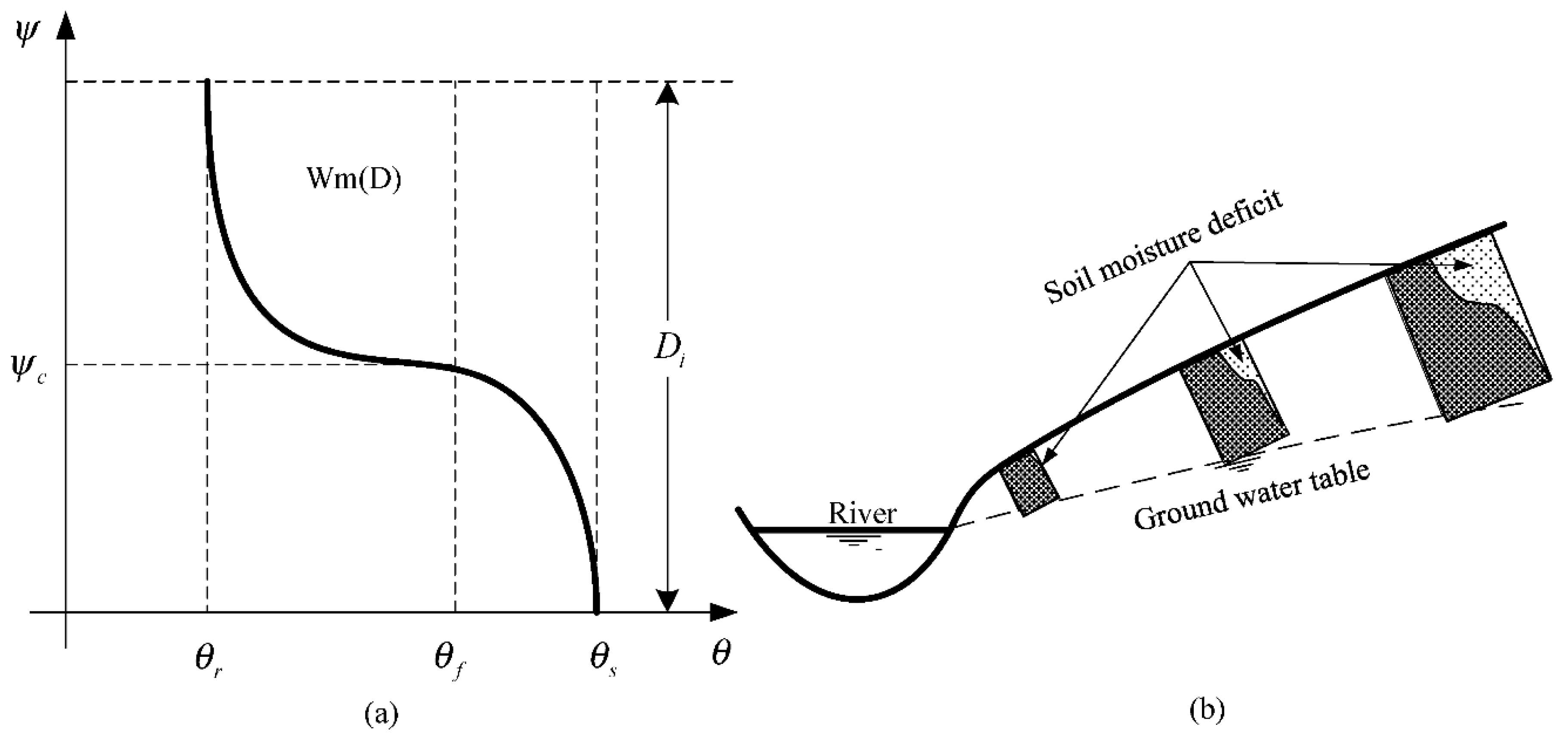
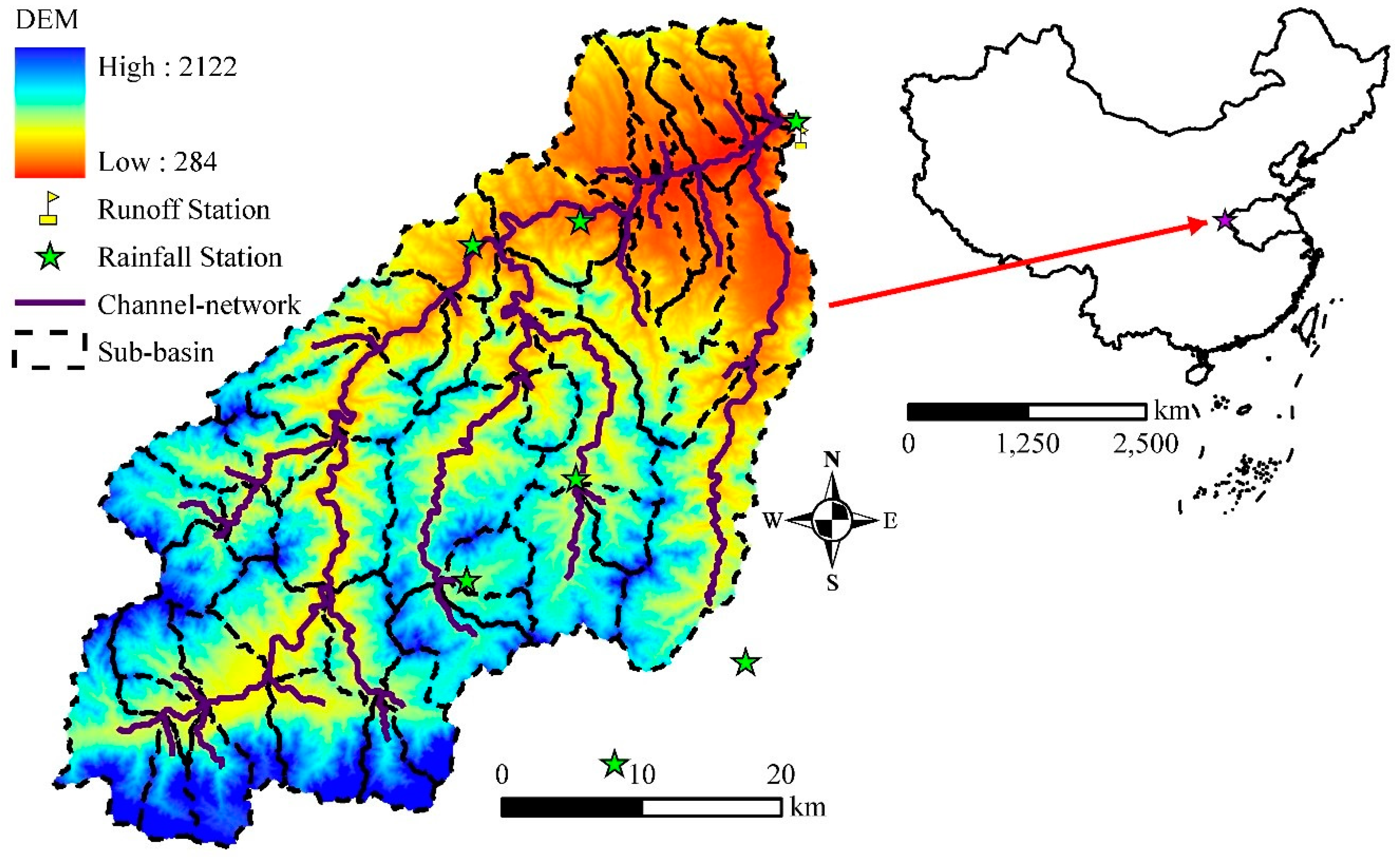
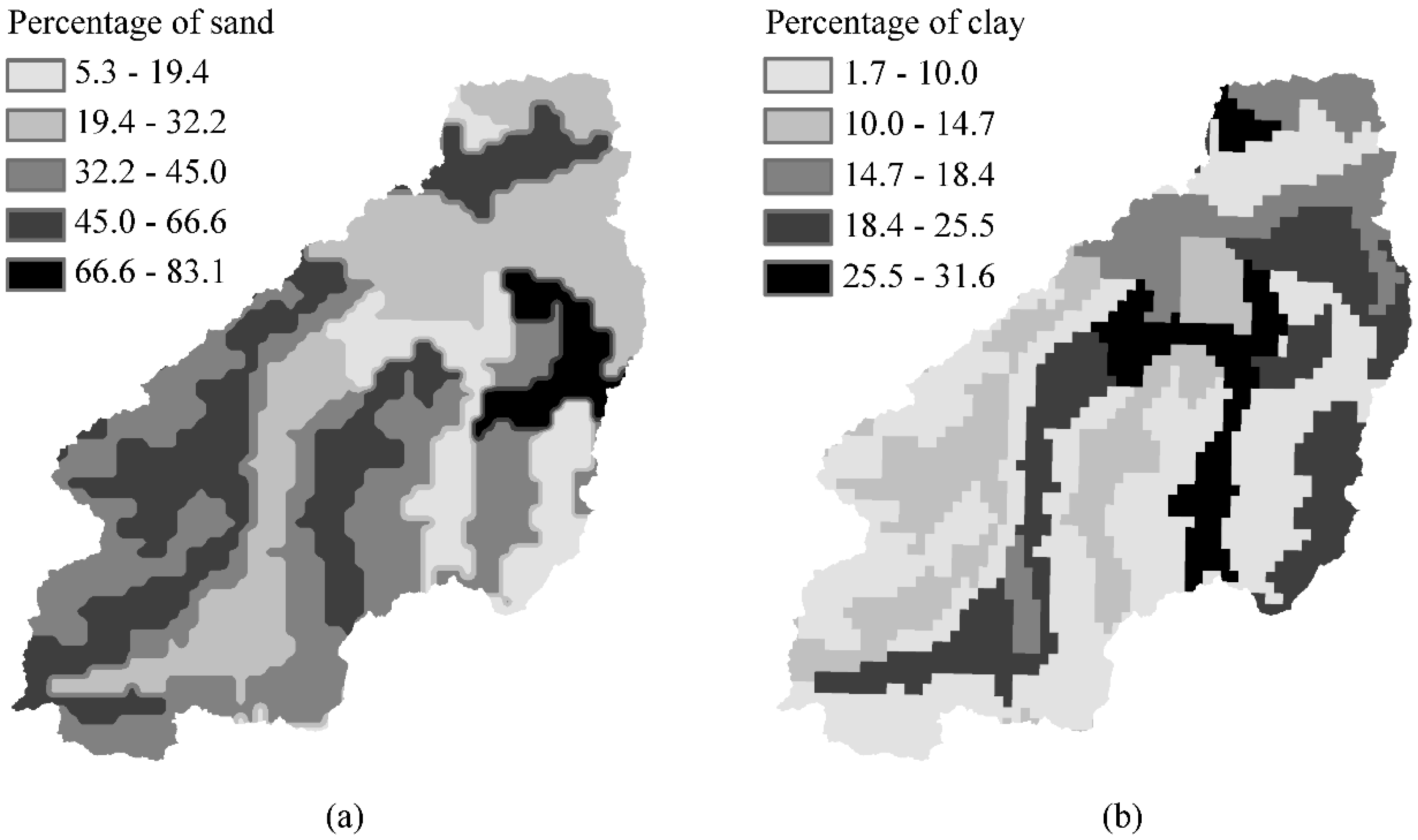
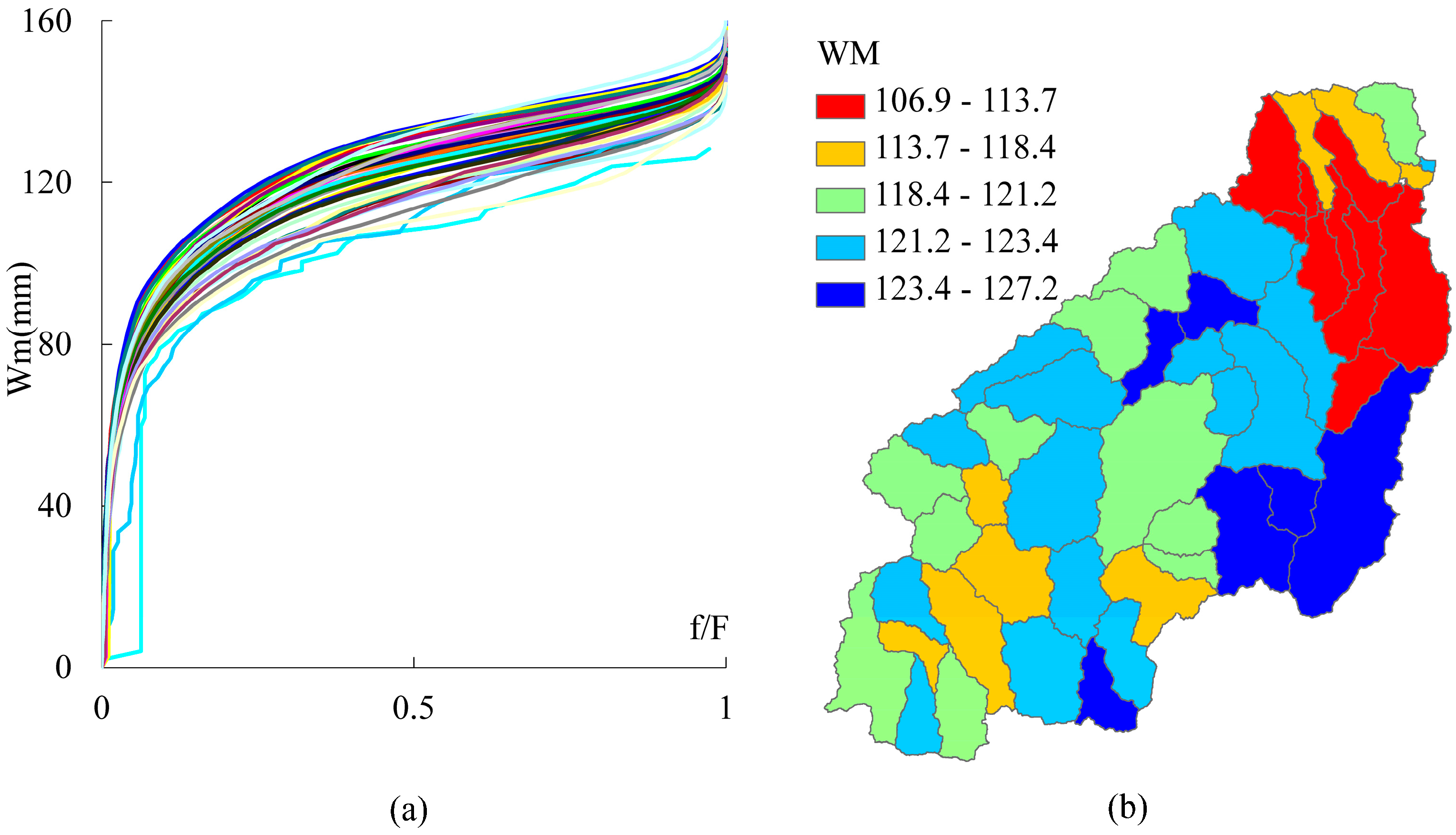
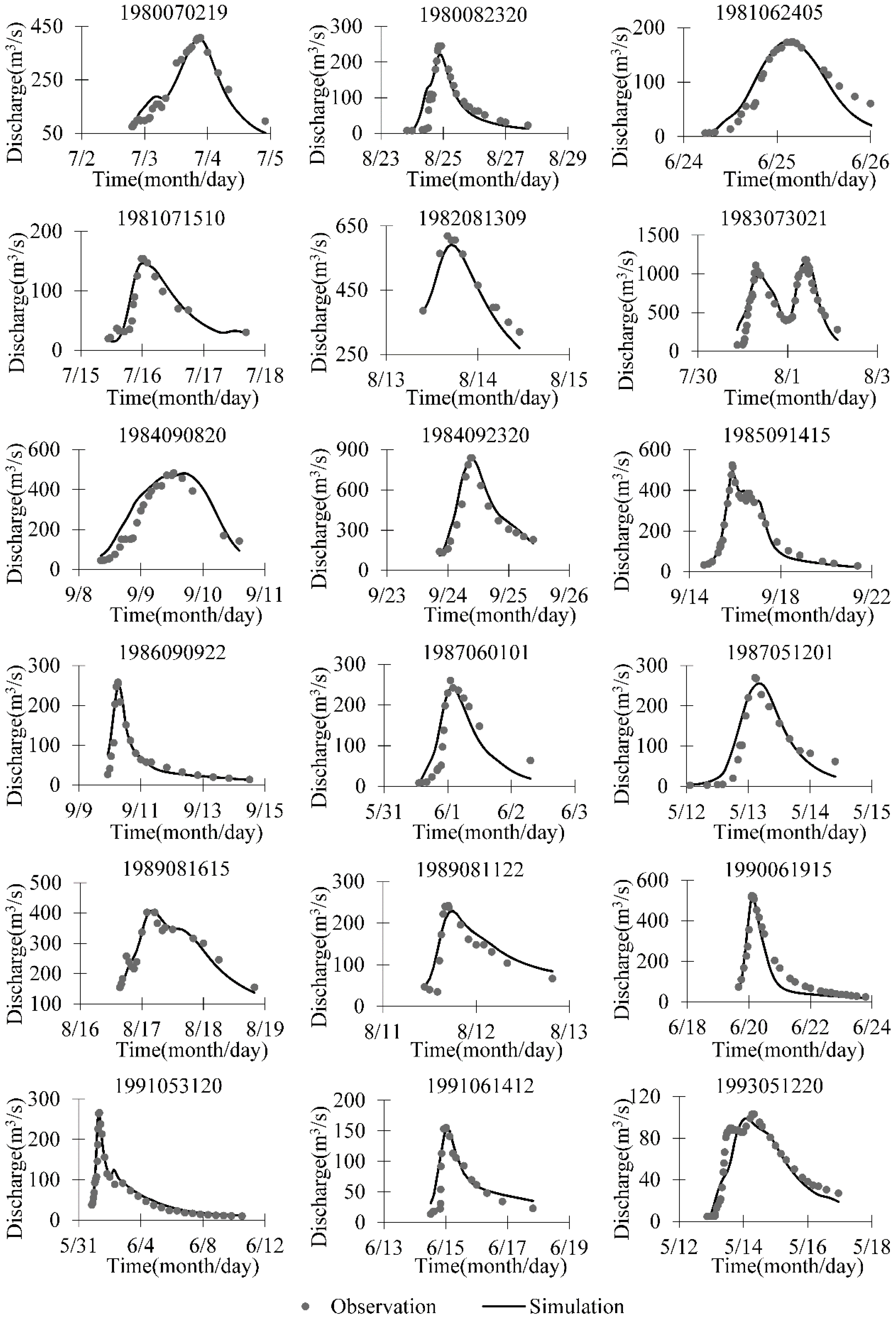
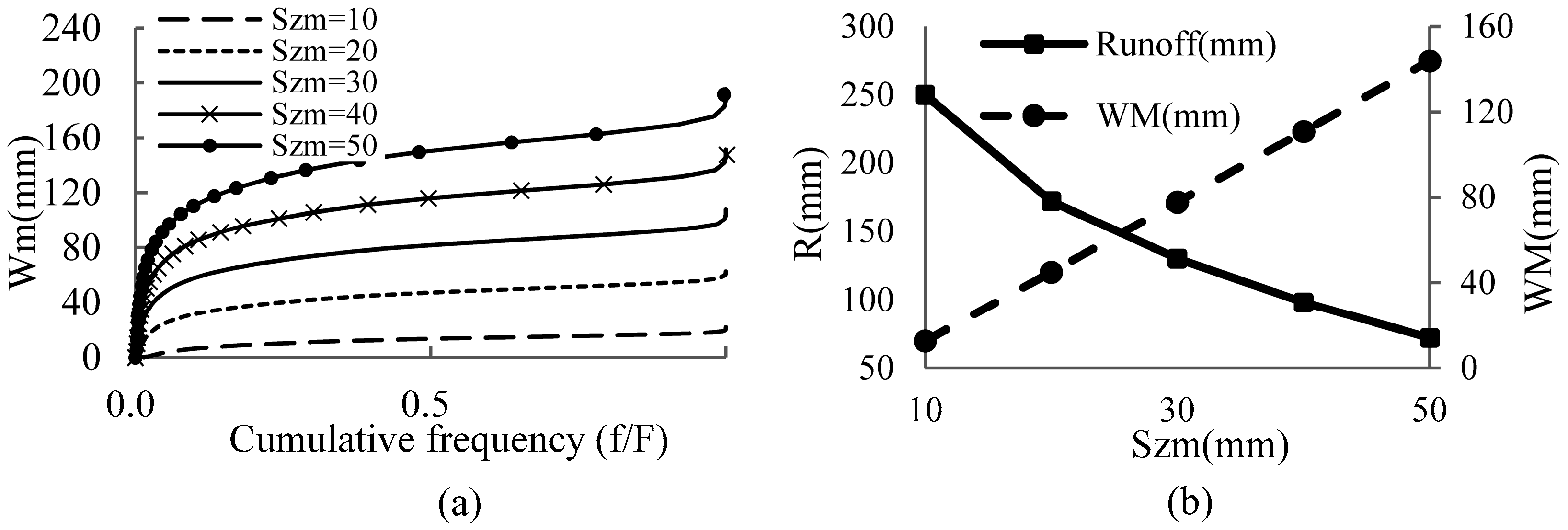
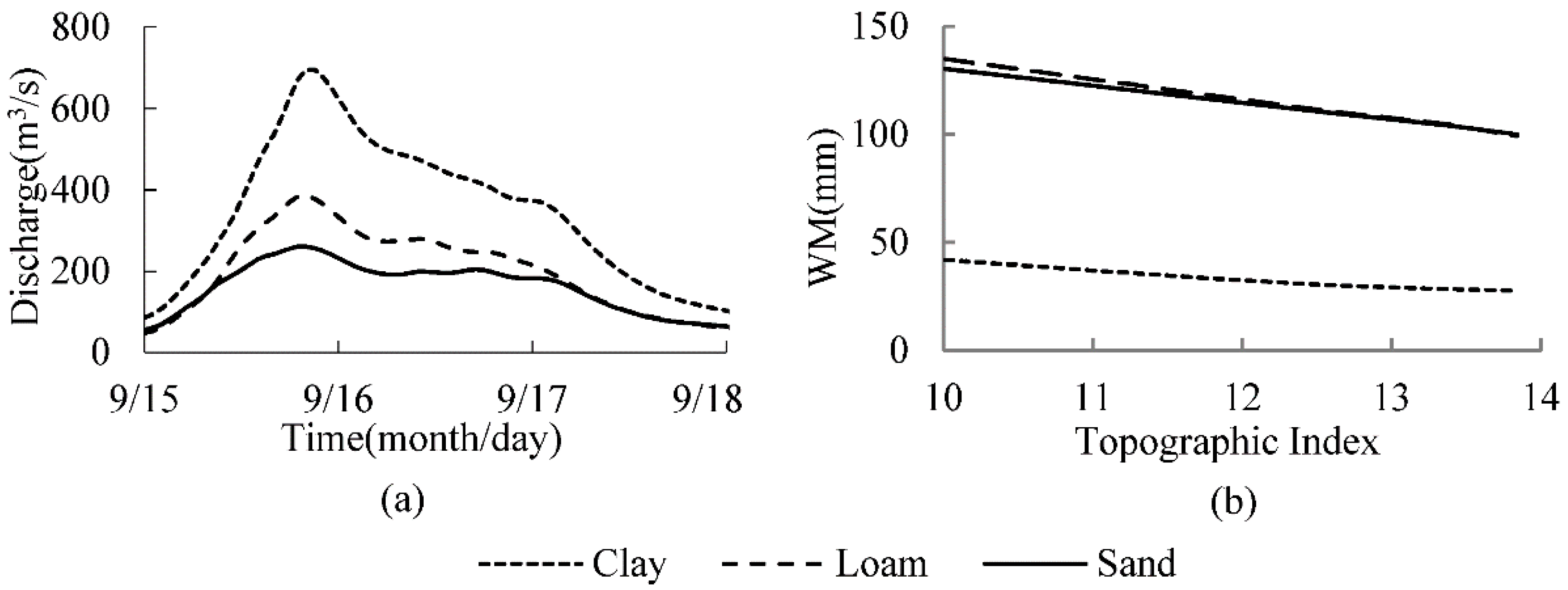

| Parameter | Sand | Loam | Clay |
|---|---|---|---|
| θs | 0.37 | 0.46 | 0.51 |
| θr | 0.058 | 0.083 | 0.102 |
| α (cm−1) | 0.035 | 0.025 | 0.021 |
| n | 3.19 | 1.31 | 1.2 |
| Parameter | Explanation | Unit | Lower Bound | Upper Bound | Value |
|---|---|---|---|---|---|
| Runoff Generation Calculation | |||||
| KC | Ratio of potential evapotranspiration to pan evaporation | 0.6 | 1.2 | 0.7 | |
| WM | Areal mean tension water capacity | mm | 92–127 | ||
| Szm | Scaling parameter based on soil properties | mm | 10 | 1000 | 42.8 |
| C | Deeper evapotranspiration coefficient | 0.08 | 0.18 | 0.17 | |
| Water Source Separation | |||||
| SM | Free water storage capacity | mm | 5 | 50 | 5/15 |
| EX | Exponential of the distribution of water capacity | 1 | 1.5 | 1.5 | |
| KG | Outflow coefficient of free water storage to the groundwater flow | 0.2 | 0.6 | 0.4 | |
| KI | Outflow coefficient of free water storage to the interflow | 0.2 | 0.6 | 0.3 | |
| Concentration Calculation | |||||
| CS | Recession constant of surface water storage | 0 | 0.7 | 0.1/0.2 | |
| CI | Recession constant of interflow storage | 0.5 | 0.9 | 0.5/0.7 | |
| CG | Recession constant of groundwater storage | 0.5 | 0.998 | 0.995/0.98 | |
| KE | Residence time of water | h | 0.5 | 1.5 | 1 |
| XE | Muskingum coefficient | 0 | 0.5 | 0.3 | |
| Period | Year | Annual P | Annual E | R (mm) | RE (%) | RMSE | NSC | |
|---|---|---|---|---|---|---|---|---|
| (mm) | (mm) | Obs | Sim. | (mm) | ||||
| Calibration | 1979 | 898.3 | 542.3 | 227 | 226.1 | −0.42 | 1.1 | 0.77 |
| 1980 | 792 | 470.6 | 188.1 | 196.1 | 4.24 | 1.0 | 0.73 | |
| 1981 | 653.6 | 464.4 | 94.6 | 98.4 | 3.99 | 0.6 | 0.58 | |
| 1982 | 1096.3 | 435.3 | 551.1 | 523.1 | −5.06 | 4.4 | 0.91 | |
| 1983 | 1222.8 | 519.1 | 644.3 | 607.1 | −5.78 | 2.8 | 0.87 | |
| 1984 | 984.6 | 557 | 362.1 | 337.9 | −6.69 | 1.5 | 0.78 | |
| 1985 | 873.5 | 489.5 | 296.4 | 298.4 | 0.68 | 1.5 | 0.78 | |
| 1986 | 596.1 | 433.4 | 80.9 | 79.5 | −1.73 | 0.6 | 0.47 | |
| 1987 | 736.6 | 469.4 | 146.4 | 153.2 | 4.64 | 1.1 | 0.56 | |
| 1988 | 803.3 | 380.3 | 224.4 | 233.2 | 3.92 | 1.6 | 0.85 | |
| Mean | 865.7 | 476.1 | 281.5 | 275.3 | −0.22 | 1.6 | 0.73 | |
| Validation | 1989 | 854.6 | 408.6 | 257.9 | 268.8 | 4.23 | 1.4 | 0.74 |
| 1990 | 870.3 | 554.5 | 258.8 | 257.7 | −0.44 | 1.4 | 0.87 | |
| 1991 | 605.5 | 475.7 | 120.1 | 109.2 | −9.1 | 0.7 | 0.67 | |
| 1992 | 741.7 | 467.5 | 108.1 | 104 | −3.85 | 0.7 | 0.75 | |
| 1993 | 647.8 | 492.2 | 95.1 | 99.8 | 4.93 | 0.6 | 0.83 | |
| 1994 | 867.3 | 473.4 | 155.3 | 166 | 6.94 | 1.4 | 0.73 | |
| 1995 | 731.4 | 407.8 | 151.3 | 153.2 | 1.27 | 1.1 | 0.81 | |
| Mean | 759.8 | 468.5 | 163.8 | 165.5 | 0.57 | 1.0 | 0.77 | |
| Flood No. | P | E | Flood Volume (106 m3) | Peak Discharge (m3/s) | RMSE | NSC | |||||
|---|---|---|---|---|---|---|---|---|---|---|---|
| (mm) | (mm) | Vobs | Vsim | RE (%) | Qobs | Qsim | RE (%) | (m3/s) | |||
| Calibration | 1980070219 | 32.4 | 5.7 | 41.6 | 39.4 | −5.28 | 408.0 | 407.3 | −0.18 | 30.9 | 0.94 |
| 1980082320 | 26.3 | 4.4 | 23.4 | 24.9 | 6.31 | 245.0 | 227.2 | −7.26 | 37.5 | 0.71 | |
| 1981062405 | 30.0 | 4.7 | 15.4 | 14.2 | −7.85 | 174.0 | 175.2 | 0.66 | 7.9 | 0.87 | |
| 1981071510 | 12.7 | 4.3 | 13.2 | 13.3 | 0.88 | 154.0 | 146.4 | −4.94 | 25.3 | 0.79 | |
| 1982081309 | 31.7 | 0.9 | 57.3 | 52.8 | −7.82 | 619.0 | 591.6 | −4.43 | 42.1 | 0.89 | |
| 1983073021 | 68.7 | 4.7 | 119.3 | 126.3 | 5.89 | 1180.0 | 1153.3 | −2.26 | 121.6 | 0.83 | |
| 1984090820 | 49.1 | 4.9 | 52.6 | 62.2 | 18.34 | 483.0 | 481.2 | −0.37 | 68.8 | 0.80 | |
| 1984092320 | 41.9 | 0.9 | 53.8 | 60.8 | 13.07 | 838.0 | 827.5 | −1.26 | 71.1 | 0.92 | |
| 1985091415 | 82.5 | 5.2 | 91.3 | 86.8 | −4.97 | 524.0 | 496.5 | −5.26 | 22.9 | 0.98 | |
| 1986090922 | 7.0 | 0.9 | 12.9 | 14.5 | 12.73 | 258.0 | 249.5 | −3.31 | 36.8 | 0.81 | |
| 1987060101 | 27.5 | 4.1 | 16.3 | 14.9 | −8.61 | 260.0 | 233.0 | −10.40 | 33.3 | 0.87 | |
| 1987051201 | 47.2 | 3.3 | 18.0 | 19.8 | 10.06 | 270.0 | 255.6 | −5.35 | 36.1 | 0.84 | |
| Mean | 38.1 | 3.7 | 42.9 | 44.2 | 2.73 | 451.1 | 437.0 | −3.70 | 44.5 | 0.85 | |
| Validation | 1989081615 | 111.0 | 13.7 | 116.9 | 110.3 | −5.71 | 402.0 | 408.1 | 1.51 | 29.7 | 0.93 |
| 1989081122 | 11.1 | 1.3 | 13.8 | 15.5 | 12.29 | 242.0 | 229.1 | −5.34 | 31.9 | 0.80 | |
| 1990061915 | 33.2 | 10.7 | 50.9 | 40.2 | −21.16 | 524.0 | 517.6 | −1.23 | 41.6 | 0.95 | |
| 1991053120 | 45.8 | 28.8 | 41.5 | 46.8 | 12.79 | 266.0 | 269.7 | 1.37 | 24.6 | 0.89 | |
| 1991061412 | 18.5 | 11.4 | 16.9 | 19.5 | 15.50 | 155.0 | 155.9 | 0.56 | 23.4 | 0.72 | |
| 1993051220 | 19.8 | 5.9 | 18.7 | 17.6 | −6.08 | 103.0 | 99.0 | −3.90 | 15.6 | 0.78 | |
| 1995072422 | 52.7 | 3.5 | 36.1 | 38.2 | 5.98 | 775.0 | 706.2 | −8.88 | 85.0 | 0.74 | |
| Mean | 41.7 | 10.8 | 42.1 | 41.2 | 1.94 | 352.4 | 340.8 | −2.27 | 35.6 | 0.83 | |
© 2017 by the authors. Licensee MDPI, Basel, Switzerland. This article is an open access article distributed under the terms and conditions of the Creative Commons Attribution (CC BY) license (http://creativecommons.org/licenses/by/4.0/).
Share and Cite
Xiang, X.; Wu, X.; Chen, X.; Song, Q.; Xue, X. Integrating Topography and Soil Properties for Spatial Soil Moisture Storage Modeling. Water 2017, 9, 647. https://doi.org/10.3390/w9090647
Xiang X, Wu X, Chen X, Song Q, Xue X. Integrating Topography and Soil Properties for Spatial Soil Moisture Storage Modeling. Water. 2017; 9(9):647. https://doi.org/10.3390/w9090647
Chicago/Turabian StyleXiang, Xiaohua, Xiaoling Wu, Xi Chen, Qifeng Song, and Xianwu Xue. 2017. "Integrating Topography and Soil Properties for Spatial Soil Moisture Storage Modeling" Water 9, no. 9: 647. https://doi.org/10.3390/w9090647





